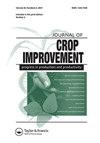在营养限制条件下,指谷草和豚草在生长和养分吸收方面的种间竞争
IF 1.5
Q3 AGRONOMY
引用次数: 1
摘要
摘要:在营养缺乏的环境中,作物与杂草的相互作用会引发对这些营养物质的强烈的种内和种间竞争。该研究调查了指状小米(FM;Eleusine coracana(L.)Gaertn.)的营养吸收在营养有限的条件下,在高地杂草几内亚草(GG;Panicum maximum Jacq)的存在下。对两个物种的不同相邻密度进行了盆栽试验,包括单一培养和混合培养。测定了两种植物种间/种内竞争对养分吸收和生长的影响。不同的植物组合影响FM对植物干重、氮、磷和钾的吸收和利用效率。与邻居来自同一物种时相比,GG存在时FM的根和茎干重显著降低。FM的组织营养浓度在1:2的FM:GG植物组合中下降幅度最大。结果表明,在养分有限的条件下,FM与GG共存时,由于强烈的种间竞争,其生长和养分吸收受到抑制。无论肥料处理和植物组合如何,GG都保持着相似的生物量,表明在生长环境中资源有限的情况下,GG有能力击败邻近物种。本研究还提供了科学证据,证明GG能够很好地适应营养不良的环境,这是通过提高生物量形成中有限营养物质的利用效率来实现的。这可能有助于GG获得与同一栖息地的其他植物相比的竞争优势,并作为入侵杂草物种在大多数农业生态系统中占据主导地位。本文章由计算机程序翻译,如有差异,请以英文原文为准。
Inter-specific competition between finger millet and Guinea grass for growth and nutrient uptake under nutrient-limited conditions
ABSTRACT Crop–weed interactions in nutrient-deficient environments can induce strong intra- and inter-specific competition for such nutrients. The study investigated nutrient uptake by finger millet (FM; Eleusine coracana (L.) Gaertn.) in the presence of the upland weed, Guinea grass (GG; Panicum maximum Jacq), under nutrient-limited conditions. A pot experiment was conducted with different neighbor-densities of the two species, including monocultures and mixed cultures. The effects of inter-specific/intra-specific competition on nutrient uptake and growth of the two plant species were measured. Varied plant combinations impacted on plant dry weight, uptake, and use efficiency of nitrogen, phosphorus, and potassium by FM. Root and shoot dry weights of FM were markedly reduced in the presence of GG compared to that when neighbors were from the same species. The largest reduction of tissue nutrient concentration of FM was recorded in FM:GG plant combination of 1:2. The results indicated that the growth and nutrient uptake of FM was suppressed when it co-existed with GG due to strong inter-specific competition under nutrient-limited conditions. GG maintained similar biomass irrespective of the fertilizer treatment and plant combinations, demonstrating its ability to outcompete neighboring species when resources are limited in the growing environment. The present study also provides scientific evidence that GG is well adapted to nutrient-poor environments, which is attained through enhancing the use efficiency of limited nutrients in biomass formation. This might have helped GG to gain the competitive advantage over other plants in the same habitat and dominate in most agro-ecological systems as an invasive weed species.
求助全文
通过发布文献求助,成功后即可免费获取论文全文。
去求助
来源期刊

Journal of Crop Improvement
Multiple-
CiteScore
3.30
自引率
7.70%
发文量
42
期刊介绍:
Journal of Crop Science and Biotechnology (JCSB) is a peer-reviewed international journal published four times a year. JCSB publishes novel and advanced original research articles on topics related to the production science of field crops and resource plants, including cropping systems, sustainable agriculture, environmental change, post-harvest management, biodiversity, crop improvement, and recent advances in physiology and molecular biology. Also covered are related subjects in a wide range of sciences such as the ecological and physiological aspects of crop production and genetic, breeding, and biotechnological approaches for crop improvement.
 求助内容:
求助内容: 应助结果提醒方式:
应助结果提醒方式:


